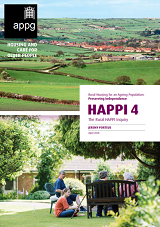How can housing associations play a lead role in levelling up rural areas?

It’s #RuralHousingWeek and the Housing LIN would like to draw your attention to a range of useful resources that address the challenges facing housing in rural communities, including an Inquiry report that made several 'rural proofing' recommendations to increase the quality, supply, and range of more appropriate age-friendly housing.
What is #RuralHousingWeek?
If we want to tackle the challenges facing housing in rural communities, we need to ask how can housing associations play a lead role in levelling up rural areas?
Rural Housing Week is an annual campaign to showcase the fantastic work housing associations do in rural communities. This year, Rural Housing Week takes place between 4th – 8th July and is an opportunity to highlight the many ways in which housing associations are working to support the levelling up agenda in rural areas.
Rural Housing for an Ageing Population: Preserving Independence (HAPPI 4)
In 2018, an Inquiry established by the All-Party Parliamentary Group for Housing and Care for Older People concluded that older people's housing is neglected in rural areas.
The Inquiry report made several 'rural proofing' recommendations to increase the quality, supply and range of more appropriate age-friendly housing. It suggested an adaptation of the HAPPI principles when designing new homes for older people in rural areas, noting that new housing could preserve independence for older people and save NHS and social care funds.
It also recognised the need to build greater resilience and connectivity amongst local communities across all ages in the countryside and called for wider community-led support solutions that have enabled people to remain in their own village and stay connected in isolated rural communities. Following publication, Sue Chalkley, former Chief Executive at Hastoe Housing Association and panel member of this APPG Inquiry, reflected on HAPPI4 in a Housing LIN blog that emphasised the need to create homes in rural areas for the elderly.
We would love to hear your stories of community-led support solutions that have enabled people to remain connected in isolated rural communities. Share them with us on Twitter @HLINComms (opens new window)!
If you found this of interest, you're welcome to browse our Homes and Communities webpage that offers a range of resources, tool and best practice examples on the impact that home design and environment, as well as the community the individual lives in, has on managing loneliness and isolation. They refer to how both rural and urban living distinctly affect individuals’ social connections.
